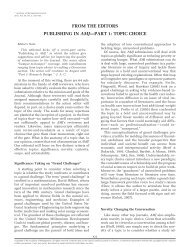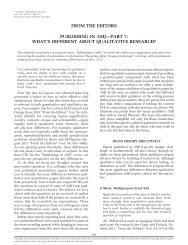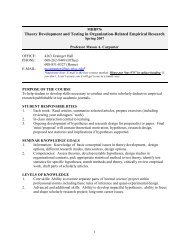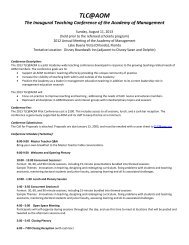inductive reasoning and the creation and justification of new ventures
inductive reasoning and the creation and justification of new ventures
inductive reasoning and the creation and justification of new ventures
Create successful ePaper yourself
Turn your PDF publications into a flip-book with our unique Google optimized e-Paper software.
2010 Cornelissen <strong>and</strong> Clarke<br />
555<br />
Douglas, M. 1986. How institutions think. Syracuse, NY: Syracuse<br />
University Press.<br />
Edwards, D. 1997. Discourse <strong>and</strong> cognition. London: Sage.<br />
Epley, N., & Gilovich, T. 2006. The anchoring <strong>and</strong> adjustment<br />
heuristic: Why adjustments are insufficient. Psychological<br />
Science, 17: 311–318.<br />
Farjoun, M. 2008. Strategy making, novelty <strong>and</strong> analogical<br />
<strong>reasoning</strong>—Commentary on Gavetti, Levinthal, <strong>and</strong><br />
Rivkin (2005). Strategic Management Journal, 29: 1001–<br />
1016.<br />
Fauconnier, G. 1997. Mappings in thought <strong>and</strong> language.<br />
Cambridge: Cambridge University Press.<br />
Fauconnier, G. 2000. Methods <strong>and</strong> generalizations. In T. Janssen,<br />
& G. Redeker (Eds.), Cognitive linguistics: Foundations,<br />
scope, <strong>and</strong> methodology: 95–127. The Hague: Mouton<br />
De Gruyter.<br />
Fauconnier, G., & Turner, M. 1998. Conceptual integration<br />
networks. Cognitive Science, 22: 133–187.<br />
Fauconnier, G., & Turner M. 2002. The way we think: Conceptual<br />
blending <strong>and</strong> <strong>the</strong> mind’s hidden complexities. New<br />
York: Basic Books.<br />
Garud, R., & Karnøe, P. 2003. Bricolage vs. breakthrough:<br />
Distributed <strong>and</strong> embedded agency in technology entrepreneurship.<br />
Research Policy, 32: 277–300.<br />
Gavetti, G., Levinthal D. A., & Rivkin, J. W. 2005. Strategymaking<br />
in novel <strong>and</strong> complex worlds: The power <strong>of</strong><br />
analogy. Strategic Management Journal, 26: 691–712.<br />
Gavetti, G., & Warglien, M. 2007. Recognizing <strong>the</strong> <strong>new</strong>: A<br />
multi-agent model <strong>of</strong> analogy in strategic decisionmaking.<br />
Working paper No. 08-028, Harvard Business<br />
School, Boston.<br />
Gentner, D. 1983. Structure mapping: A <strong>the</strong>oretical framework<br />
for analogy. Cognitive Science, 7: 155–170.<br />
Gentner, D., Bowdle, B., Wolff, P., & Boronat, C. 2001. Metaphor<br />
is like analogy. In D. Gentner, K. J. Holyoak, & B. N.<br />
Kokinov (Eds.), The analogical mind: Perspectives from<br />
cognitive science: 199–253. Cambridge, MA: MIT Press.<br />
Gentner, D., & Clement, C. 1988. Evidence for relational selectivity<br />
in interpreting analogy <strong>and</strong> metaphor. In G. H.<br />
Bower (Ed.), The psychology <strong>of</strong> learning <strong>and</strong> motivation:<br />
307–358. New York: Academic Press.<br />
Gibbs, R. W., & O’Brien J. E. 1990. Idioms <strong>and</strong> mental imagery:<br />
The metaphorical motivation for idiomatic meaning.<br />
Cognition, 36: 35–68.<br />
Gioia, D. A. 1986. Symbols, scripts, <strong>and</strong> sensemaking: Creating<br />
meaning in <strong>the</strong> organizational experience. In H. P.<br />
Sims, Jr., & D. A. Gioia (Eds.), The thinking organization:<br />
49–74. San Francisco: Jossey-Bass.<br />
Gioia, D. A., & Mehra, A. 1996. Sensemaking in organizations.<br />
Academy <strong>of</strong> Management Review, 21: 1226–1230.<br />
Gioia, D. A., Thomas, J. B., Clark, S. M., & Chittipeddi. K. 1994.<br />
Symbolism <strong>and</strong> strategic change in academia: The dynamics<br />
<strong>of</strong> sensemaking <strong>and</strong> influence. Organization<br />
Science, 5: 363–383.<br />
Glucksberg, S., McGlone, M. S., & Manfredi, D. 1997. Property<br />
attribution in metaphor comprehension. Journal <strong>of</strong> Memory<br />
<strong>and</strong> Language, 36: 50–67.<br />
Goldberg, A. E. 1995. Constructions: A construction grammar<br />
approach to argument structure. Chicago: University <strong>of</strong><br />
Chicago Press.<br />
Goodman, N. 1955. Fact, fiction, <strong>and</strong> forecast. Cambridge,<br />
MA: Harvard University Press.<br />
Grégoire, D. A., Corbett, A. C., & McMullen, J. S. In press. The<br />
cognitive perspective in entrepreneurship: An agenda<br />
for future research. Journal <strong>of</strong> Management Studies.<br />
Hannan, M. T., Pólos, L., & Carroll, G. R. 2007. Logics <strong>of</strong><br />
organization <strong>the</strong>ory: Audiences, codes, <strong>and</strong> ecologies.<br />
Princeton, NJ: Princeton University Press.<br />
Hargadon, A., & Douglas, Y. 2001. When innovations meet<br />
institutions: Edison <strong>and</strong> <strong>the</strong> design <strong>of</strong> <strong>the</strong> electric light.<br />
Administrative Science Quarterly 46: 476–501.<br />
Haunschild, P. R., & Miner, A. S. 1997. Modes <strong>of</strong> interorganizational<br />
imitation: The effects <strong>of</strong> outcome salience <strong>and</strong><br />
uncertainty. Administrative Science Quarterly, 41: 472–<br />
500.<br />
Hill, R., & Levenhagen, M. 1995. Metaphors <strong>and</strong> mental models:<br />
Sensemaking <strong>and</strong> sensegiving in innovative <strong>and</strong><br />
entrepreneurial activities. Journal <strong>of</strong> Management, 21:<br />
1057–1074.<br />
Hirsch, P., & Levin, D. Z. 1999. Umbrella constructs versus<br />
validity police: A life cycle model. Organization Science,<br />
10: 199–212.<br />
Hite, J. M., & Hesterly, W. S. 2001. The evolution <strong>of</strong> firm<br />
networks. Strategic Management Journal, 22: 275–286.<br />
Holl<strong>and</strong>, J. H., Holyoak, K. J., Nisbett, R. E., & Thagard, P. R.<br />
1986. Induction: Processes <strong>of</strong> inference, learning <strong>and</strong> discovery.<br />
Cambridge, MA: MIT Press.<br />
Hutchins, E. 2005. Material anchors for conceptual blends.<br />
Journal <strong>of</strong> Pragmatics, 37: 1555–1577.<br />
Korunka, C., Frank, H., Luegar, M., & Mugler, J. 2003. The<br />
entrepreneurial personality in <strong>the</strong> context <strong>of</strong> resources,<br />
environment, <strong>and</strong> <strong>the</strong> startup process—A configurational<br />
approach. Entrepreneurship Theory <strong>and</strong> Practice, 28: 23–<br />
42.<br />
Krueger, N. F., Reilly, M. D., & Carsrud, A. L. 2000. Competing<br />
models <strong>of</strong> entrepreneurial intentions. Journal <strong>of</strong> Business<br />
Venturing, 15: 411–432.<br />
Lak<strong>of</strong>f, G. 1993. The contemporary <strong>the</strong>ory <strong>of</strong> metaphor. In<br />
A. Ortony, (Ed.), Metaphor <strong>and</strong> thought (2nd ed.): 202–251.<br />
Cambridge: Cambridge University Press.<br />
Lak<strong>of</strong>f, G., & Johnson, M. 1980. Metaphors we live by. Chicago:<br />
University <strong>of</strong> Chicago Press.<br />
Lak<strong>of</strong>f, G., & Johnson, M. 1999. Philosophy in <strong>the</strong> flesh: The<br />
embodied mind <strong>and</strong> its challenge to Western thought.<br />
New York: Basic Books.<br />
Langacker, R. W. 1991. Foundations <strong>of</strong> cognitive grammar.<br />
Volume II: Descriptive applications. Stanford, CA: Stanford<br />
University Press.<br />
Lounsbury, M., & Glynn, M. 2001. Cultural entrepreneurship:<br />
Stories, legitimacy, <strong>and</strong> <strong>the</strong> acquisition <strong>of</strong> resources.<br />
Strategic Management Journal, 22: 545–564.










